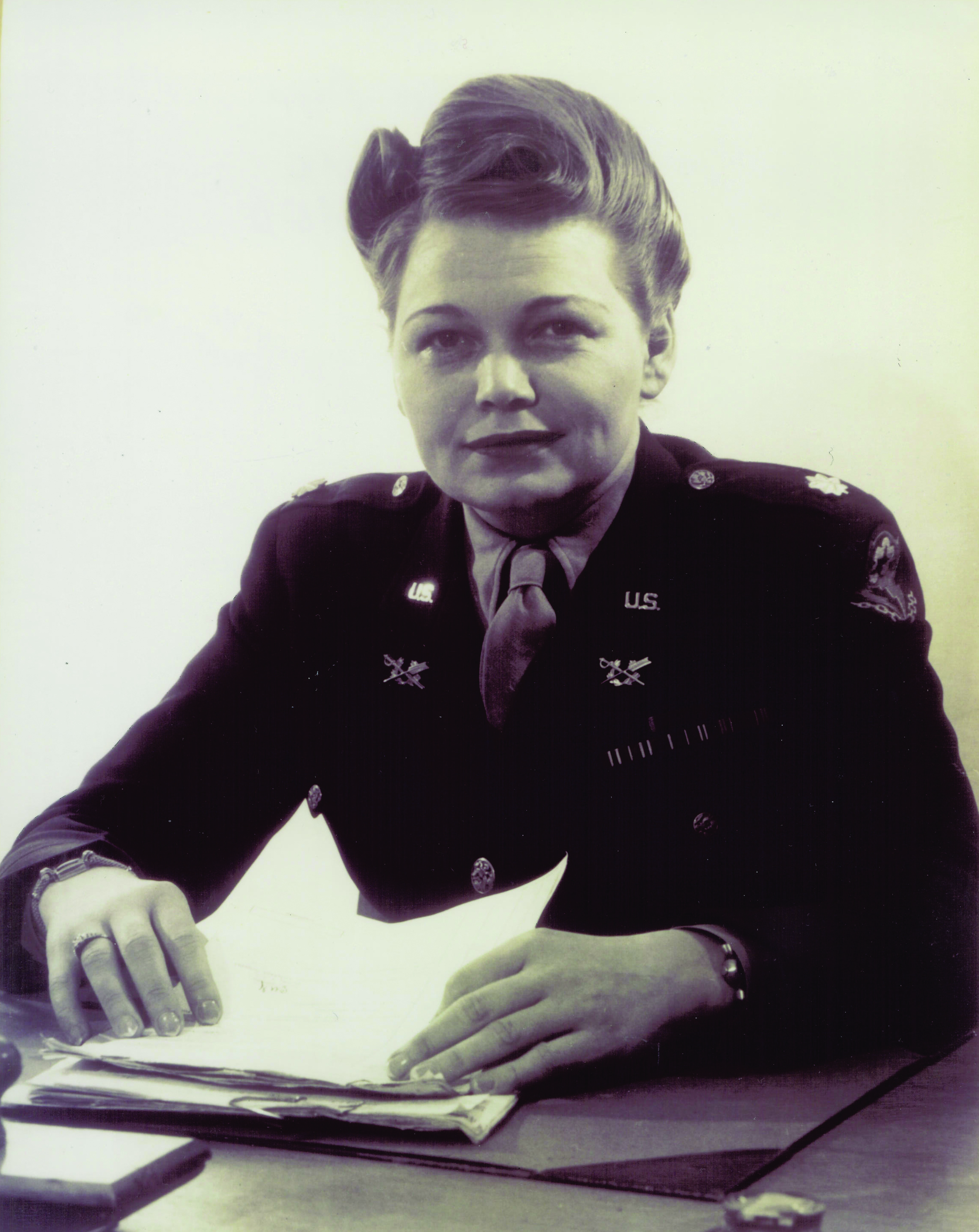
Phyllis L. Propp-Fowle, the first female Judge Advocate. (Courtesy Fred L. Borch III)
Lore of the Corps
Women in the Corps
A Short History of Female Judge Advocates
By Fred L. Borch III
While lawyers have been in the Army from the days of the Revolution, there were no female judge advocates until 1944, when Captain (CPT) Phyllis Propp-Fowle, an attorney serving in the Women’s Army Corps (WAC), traded her WAC branch insignia for the crossed-quill-and-sword worn by all officers in the Judge Advocate General’s Department (JAGD). In the more than seventy-five years that have followed Propp-Fowle’s trailblazing career, hundreds and hundreds of female lawyers have served as Army lawyers, and what follows is a short history of their exemplary service in our Corps.
1940s to 1960s
Since the Army was gender-segregated in the 1940s, 1950s, and 1960s, the opportunities for women to soldier were limited because of this decidedly second-class status. Additionally, not only were most women in a separate Corps (the WAC), but the Congress prohibited women from serving in combat units, from commanding men, and from being promoted to general officer. Despite these restrictions, there were 9,000 women in the WAC by 1960 and 12,500 by 1970.1 But, since there were a total of 1.32 million Soldiers in the Army in 1970, this meant that less than one percent of the Army was female.2 Despite these low numbers, there were a handful of women in our Corps, and three deserve special mention because they achieved “firsts” in military legal history: Phyllis L. Propp-Fowle, Elizabeth R. Smith Jr., and Nancy A. Hunter.
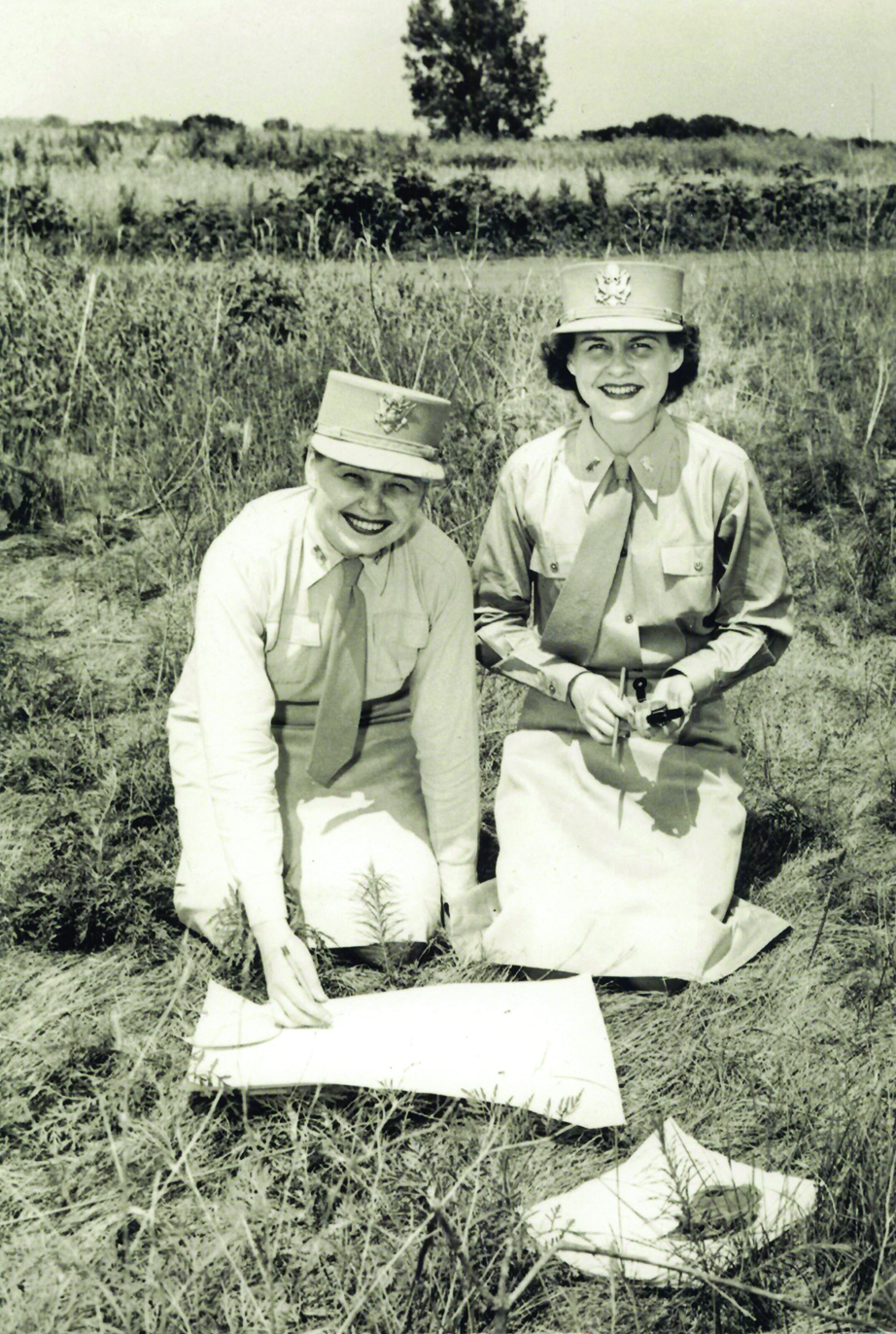
Phyllis Propp-Fowle (left) was the first female judge advocate in history. This photo was taken circa 1943.
Phyllis L. Propp-Fowle
Phyllis L. Propp-Fowle was the first female judge advocate; first female post judge advocate (similar to a command judge advocate (CJA)); first female judge advocate to earn a combat patch and overseas service stripes; and, the only female judge advocate to serve overseas in World War II. No one—male or female—is likely to have so many “firsts” again.
Born in Jasper County, Iowa, on 8 March 1908, Propp-Fowle obtained her law degree from the University of Iowa in 1933. She was the only woman in her graduating class.3
After America entered World War II, Propp-Fowle was one of the first 1,000 women to join the Women’s Army Auxiliary Corps (WAAC) in 1942. She commissioned as a second lieutenant on 3 October 1942. When Congress gave the WAAC military status as part of the Army and renamed it the Women’s Army Corps in September 1943, Propp-Fowle became one of its first members.4
Given her legal training, Propp-Fowle began requesting a transfer from the WAAC/WAC to the JAGD in mid-1942. After two years, her transfer was finally approved and, on 4 May 1944, then-CPT Propp-Fowle (she had been promoted on 30 October 1943) became the first woman to wear the judge advocate (JA) insignia on her collar. She immediately requested to attend The Judge Advocate General’s School, U.S. Army (TJAGSA) at the University of Michigan—only to be refused because the school did not accept women. Consequently, she was assigned as the Post Judge Advocate at Fort Des Moines, Iowa. This made sense, given that the WAC headquarters was located there.5
While CPT Propp-Fowle never attended TJAGSA, she did deploy to Europe in January 1945, becoming the first, and only, female judge advocate to serve overseas in World War II. She was assigned to the Office of the Staff Judge Advocate (OSJA), Headquarters, European Theater, in Paris. As a result of her duty in the European-African-Middle Eastern Theater, Propp-Fowle received a right-sleeve shoulder (combat) patch and three overseas service bars (reflecting a total of eighteen months’ service in a combat theater). She was promoted to major (MAJ) on 1 June 1945.
In early 1947, MAJ Propp-Fowle was still on active duty as a JA in Heidelberg, Germany, where she was serving as the Chief, Legal Affairs, Judge Advocate Division, U.S. Forces European Theater. At this time, however, the Army decided to discharge all women then serving. Propp-Fowle was released from active duty on 21 July 1947, and awarded the newly created—and then-prestigious—Army Commendation Ribbon.
Propp-Fowle was immediately rehired as a civilian attorney in the Military Affairs Branch, Judge Advocate Division, Headquarters, European Command, in Heidelberg, Germany. In this position, she prepared circulars and other directives, drafted legal opinions interpreting U.S. law and Army and European Command directives, examined contracts for legal sufficiency, and supervised the legal assistance program in the European Command. She also remained in the JAGD as a Reservist, and was promoted to lieutenant colonel (LTC), WAC-Reserve, in 1949.6
Propp-Fowle remained in Heidelberg until 1951, when she married Mr. Farnsworth Fowle, a newspaper reporter for the New York Times, and returned to the United States. She subsequently practiced law in New York City. Propp-Fowle remained in the Army Reserve and retired as a LTC in 1968. In 1999, she was inducted as a “Distinguished Member of the Regiment.” She died on 12 June 2000 at ninety-two years old. A suite of rooms at The Judge Advocate General’s Legal Center and School (TJAGLCS) has been dedicated to her memory in recognition of her many contributions to the Army and the JAG Corps.
.jpg?ver=f2jxifXRnPJyXl7AXfxeaQ%3d%3d)
Elizabeth Smith Jr. was the first female to reach the rank of colonel in the Corps.
Elizabeth R. Smith Jr.
“Liz” Smith was the first female attorney to attain the rank of colonel.7 She also was the first female judge advocate to graduate first in the Judge Advocate Basic Course. Colonel Smith also holds the record in the Corps for having been a CJA to a commanding general for twelve consecutive years.
Born in Ravenna, Kentucky, on 27 December 1926, she was the only child of R.W. and Elizabeth Ratliff Smith. Colonel Smith really was a “junior” because she was named after her mother.8
Smith grew up in Irvine, Kentucky, and entered the University of Kentucky in 1944 in a six-year combined Bachelor of Arts and Bachelor of Laws degree program. After graduating in 1950, motivated by patriotism (the Korean War was underway), adventure, and a desire to get away from the small Kentucky town in which she had grown up, Smith applied to join the WAC. She was accepted, commissioned as a second lieutenant, and completed the WAC basic course at Fort Lee, Virginia.9
Smith served first at Fort Eustis before being reassigned to Heidelberg, Germany, in March 1954. The plan was for now-First Lieutenant Smith to work as a supply officer in a Quartermaster unit in U.S. Army, Europe, but when the senior WAC officer in Europe learned that Smith was an attorney, this officer arranged for Smith to be assigned to the Northern Area Command legal office located near Frankfurt. First Lieutenant Smith spent three years in Germany, and served in legal assistance, administrative law, and military justice. She was not formally assigned or even detailed to the JAG Corps; Smith remained a member of the Army WAC.10
In 1957, 1LT Smith applied to attend the 25th Special Class (the forerunner of today’s Judge Advocate Basic Course). She completed the course, graduating first in in her class.11 A letter to Smith from Major General George Hickman Jr., then serving as The Judge Advocate General (TJAG), congratulated 1LT Smith for finishing number one in the Special Class. Hickman also wrote that this “award has added significance when it is realized that you [Smith] were competing with 54 other officer lawyers who graduated from better law schools.”12 One has to wonder what Smith thought of this backhanded compliment.
First Lieutenant Smith was then assigned to Fort McClellan, where she was an instructor in the General Military Subjects Division, WAC Training Battalion. Promoted to captain in 1958, Smith then served a one-year tour as the commanding officer of Company B, WAC Training Battalion, “an opportunity she thoroughly enjoyed.”13
Captain Smith next served at Fort Leavenworth, Kansas, where she was the only female judge advocate in the OSJA. She still had her WAC status, but was now temporarily detailed to the JAG Corps for a period of three years.14
In 1961, at the urging of Major General Charles L. “Ted” Decker, the Army formally granted qualified WAC officers permanent detail to the JAGD. Smith applied for the new status, which was approved. This permanent status with the Corps meant that while she remained in the WAC, CPT Smith’s career was now managed by the JAG Corps rather than by the WAC Career Management Branch. It also meant that CPT Smith was authorized to wear JAG Corps brass on her uniform.15
Captain Smith’s next assignment was to TJAGSA, where she worked as the Deputy Director of the Academic Department. The only female lawyer on the staff and faculty, Smith “managed the school’s academic schedule, guest speakers, coordinated support to the academic departments, and otherwise assisted in the administration of the academic program.”16 It was not easy to be a lone woman at TJAGSA, especially as not every male Soldier was convinced that women should be in Army uniforms. Certainly, CPT Smith’s supervisors were aware that some Soldiers held those views, as reflected in this senior rater comment from COL John F. T. Murray, the TJAGSA Commandant: “For anyone with a built in prejudice against women lawyers, I suggest a tour with Major Smith. She will overcome the prejudice and demonstrate why she is an outstanding officer.”17
After a promotion, now-MAJ Smith completed the 13th Career Course (today’s Graduate Course) in 1965, finishing in the top third of the class. Then, she joined the Military Affairs Division, Administrative Law Division, Office of the Judge Advocate General (OTJAG). In her opinion, “it was one of the best assignments you could have.”18 As she put it in her oral history:
It was far better than the Military Law Division, International Law, or anything else because a commander’s “meat and potatoes” is running his post, camp, or station, and he is going to be in the area of administrative law far more than the courts-martial. Anybody can do courts-martial. I think it takes real talent to do Administrative Law.19
In December 1966, then-LTC Smith left the Pentagon for an assignment as the first legal advisor for the U.S. Army Recruiting Command (USAREC), then located in Hampton, Virginia. Her job as the command’s first CJA was challenging, as the Vietnam War was in full swing and the increasing unpopularity of the draft meant that Smith and her staff wrestled with a variety of issues, including sometimes violent anti-war demonstrations at Armed Forces Examining and Entrance Stations, and handling responses to private habeas corpus actions used to impede the induction of men who had been drafted.20
When USAREC moved from Virginia to Fort Sheridan, Illinois, LTC Smith went with it. On 10 July 1972, while still serving as the CJA at USAREC, Smith made history as the first female judge advocate to reach the rank of colonel. The following year, after the draft and inductions ended, COL Smith helped USAREC transform itself so that it could better focus on recruiting for an all-volunteer Army. She was particularly interested in institutional changes at USAREC that would create more opportunities for women in the Army. In any event, COL Smith was so valued by the command at USAREC that she remained as its top judge advocate until she retired—with more than twenty-six years of service—on the last day of May 1978, the last twelve having been exclusively at USAREC.21
In retirement, Liz Smith continued to play golf (she described herself as “fair” at the game) and collect opera records. Opera, in fact, was her passion and the last month of her tour in Germany, she went “to the opera every week.”22 Colonel Smith died at her home in Newport News, Virginia, on 8 July 2007, at eighty-one years old.
Nancy A. Hunter
After entering the Corps in 1967, Nancy Hunter became the first female judge advocate to deploy to Vietnam and the first female military judge in Corps history. She also was the first female Army lawyer to be decorated with the Bronze Star Medal. Hunter also was the first female instructor on the faculty at TJAGSA.
Born in Detroit, Michigan, on 20 June 1939, Hunter graduated from the University of Colorado with a degree in business. She then joined the Navy, serving as a Supply Corps Officer from 1959 to 1964, when she began law school at Georgetown University. After graduating in 1967, and passing the New York and Virginia bar examinations, Hunter transferred from the U.S. Naval Reserve to the Army and the Corps. She completed the 47th Judge Advocate Officer Basic Course in December 1967.23
Promoted to major in March 1968, Hunter served in Japan until 1970, when she deployed to Vietnam and was assigned to the U.S. Army Judiciary. At the end of her tour of duty as a special court-martial judge, MAJ Hunter was decorated with the Bronze Star Medal—most likely the first female judge advocate to receive this medal.24
Major Hunter’s next assignment was at TJAGSA. She first taught in the Civil Law Division and then moved to be an Instructor, Criminal Law Division—both jobs resulting in her being the first female faculty member in our history.25 Hunter retired as a lieutenant colonel in 1979.
Four other female judge advocates from these early years deserve mention: LTC Nora G. Springfield, the first WAC granted permanent detail to the Corps in 1961; MAJs Mary Attaya and Ann Wansley, the first two female judge advocates in history to attend the Career Course (12th Class, 1963-64); and CPT Adrienne M. McOmber, the first lawyer permanently detailed to the Corps directly from civilian life in 1966.26
1970s to 1990s
The end of the draft after the Vietnam War and the elimination of the WAC as a separate part of the Army meant increased opportunities for women who wanted to soldier. The JAG Corps also recognized that it should encourage female attorneys to serve as JAs. By 1974, the total number of female attorneys in uniform increased from twenty-one to forty-five.27 Here, in alphabetical order, are some of the many notable female judge advocates from the last three decades of the twentieth century.

BG Malinda Dunn was the first active component female to reach flag rank in the Corps.
Malinda Dunn
Malinda Dunn was the first female attorney to serve as the Staff Judge Advocate (SJA) of the 82d Airborne Division and XVIII Airborne Corps. She also was the first active component female JA to be promoted to brigadier general.
Born in Parkersburg, West Virginia, Dunn graduated with her Bachelors of Science from Randolph-Macon College in Virginia and received her law degree from Washington and Lee University in Virginia. She received a direct commission into our Corps in June 1981. As a captain, Dunn served at the 2nd Infantry Division, 82nd Airborne Division, and 4th Infantry Division. After completing the 36th Graduate Course in 1988, she worked in the Procurement Fraud Division in the Pentagon before returning to Fort Bragg, where she was assigned to U.S. Army Special Operations Command before rejoining the 82nd Airborne Division to serve as its Deputy Staff Judge Advocate (DSJA) and the SJA—the first female judge advocate to serve as the division’s top lawyer. Then-MAJ Dunn also worked at XVIII Airborne Corps as the Chief, Administrative Law Division.28
After completing Command and General Staff College at Fort Leavenworth, now-LTC Dunn was assigned to the 25th Infantry Division as its DSJA. Her next tour of duty was in the Pentagon, where she served as the field grade assignments officer and subsequently the Chief, Personnel, Plans and Training Office (PP&TO), OTJAG. After completing her studies at the National War College in June 2002, then-COL Dunn served as the SJA at the Joint Readiness Training Center and Fort Polk until March 2003, when she became the first female JA to be the SJA at XVIII Airborne Corps. Her assignment at XVIII Airborne Corps included tours as the SJA, Combined Joint Task Force-180, Bagram Air Force Base, Afghanistan, Operation Enduring Freedom from March—May 2003; and the SJA, Multi-National Corps-Iraq, Operation Iraqi Freedom from January through July 2005.29
Selected for promotion to brigadier general in 2005, Dunn was the Commander, USALSA, and Chief Judge, USACCA, before serving as the Assistant Judge Advocate General for Military Law and Operations, OTJAG. Brigadier General Dunn retired on 1 January 2010. Today, she is the Executive Director for the American Inns of Courts, a professional non-partisan association of lawyers, judges, and other legal professionals.30
 TJAGLCS 5 Nov 2016.jpg?ver=JReM7f8HMoj8VzThld4oBQ%3d%3d)
LTC Pam Kirby USA was one of the first female officers selected for the Funded Legal Education Program.
Pamela Kirby
Pam Kirby entered the Army in 1973, with encouragement from her father, a retired Army Infantry officer, and from her fiancé CPT Robert (Bob) Kirby, an active duty JAG Corps officer. Kirby completed the Women’s Army Corps Officer Basic Course and then, as one of the first group ofwomen to be sent through officer training in formerly all-male branches of the Army, she completed the Military Intelligence Officer Basic Course and was detailed to Military Intelligence (MI). After three years as an MI officer, Kirby applied for and was selected for the Funded Legal Education Program (FLEP). She was the second female Army officer to be selected for the program.31 The Funded Legal Education Program had been created two years earlier to allow up to twenty-five active duty officers a year from each of the services to attend law school at government expense. Kirby was the only female officer that year out of the twenty-five officers selected.
Kirby completed law school at the University of Virginia and was transferred to our Corps, thereby making her and her husband, then-MAJ Bob Kirby, one of the earliest “JAG Corps couples.” While it is not uncommon today for one JA to be married to another, this was unusual in the 1970s, given the limited opportunities for women in the Army generally and the small number of female lawyers in the Corps in particular.
Kirby served in a variety of locations and assignments as a JA. In the mid-1980s Kirby served in Germany as the Chief, Criminal Law, 3rd Armored Division, where she dealt with repercussions from allegations of unlawful command influence resulting from public remarks made by the division commander.32 Kirby served as the Chief, Judge Advocate Recruiting Office, in the late 1980s, and was instrumental in bringing on active duty Malinda Dunn, who would be the first active component brigadier general in the Corps.
In 1993, after serving twenty and one-half years in the Army, Pam Kirby retired in the rank of lieutenant colonel. Her husband Bob retired then as well after twenty-six years of active duty in the rank of colonel. After moving to Orlando, Florida, Kirby went on to have a successful second career as an associate dean and legal studies faculty at the University of Central Florida (UCF). She retired from UCF in 2012.
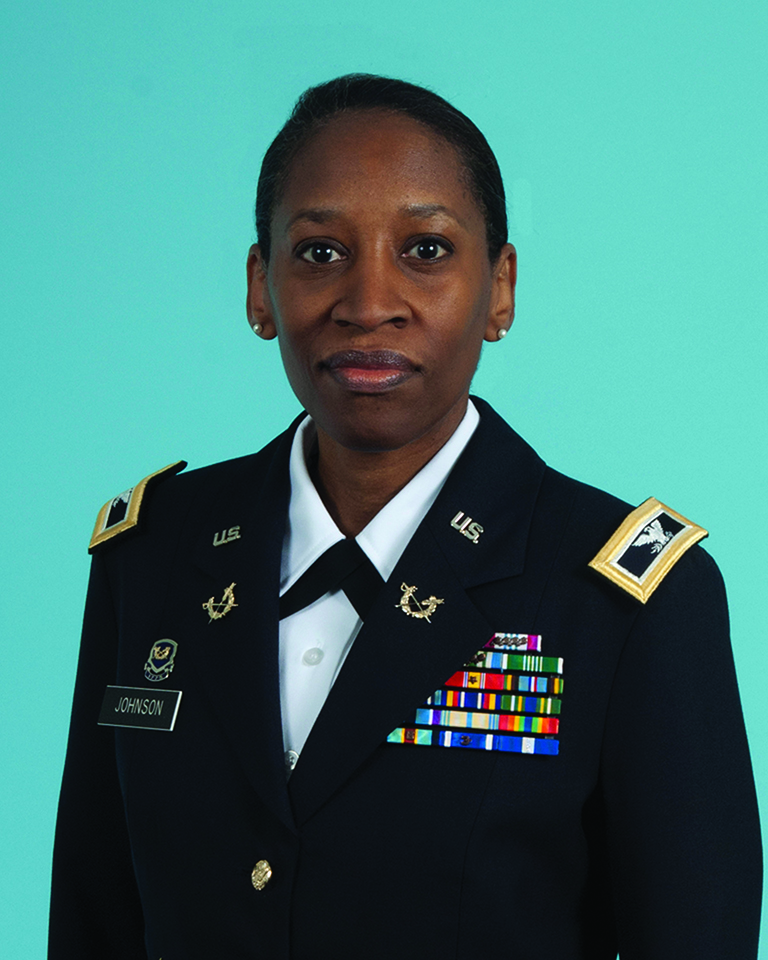
COL Tia Johnson was the first African-American female to be promoted to colonel.
Musetta Tia Johnson
In 2002, Musetta Tia Johnson made history as the first African-American female in the Corps to be promoted to the rank of colonel. She also was the first African-American female to earn an LL.M. at TJAGSA.
In her nearly thirty years of outstanding service as an Army lawyer (she retired from active duty in 2013), COL Johnson specialized in international and national security law, and served in a variety of overseas locations, including Bosnia, Cuba, Italy, and Korea. She was the top Army lawyer in Korea from 2008 to 2010. In her final assignment in our Corps, Johnson was the Senior Military Assistant to the Department of Defense General Counsel.33
In retirement, Johnson first served as the Senior Advisor to the Director, U.S. Immigration and Customs Enforcement and then as the Assistant Secretary for Legislative Affairs, U.S. Department of Homeland Security. In this latter position, she was the department’s principal liaison with the Congress, where she worked closely with authorization, appropriation, and oversight committees in both the House and Senate.34 She currently is the Director, National Security Law LL.M. Program at Georgetown University and serves there as a Visiting Professor of Law.35
Sarah Park Merck
Sarah Merck was the first female Director of Academics at TJAGSA and the first woman judge advocate promoted below the primary zone to colonel.
After graduating from Georgia State University in 1972 and earning her law degree from Emory University in 1979, Merck was directly commissioned into the Corps. She then served at a variety of locations, including: Fort Knox, Kentucky; Stuttgart, Germany; Leavenworth, Kansas; and the Pentagon.36 Then-MAJ Merck taught criminal law at TJAGSA from 1988 to 1991, and returned almost ten years later to be the school’s first female academic director in 1999. Colonel Merck retired from active duty in 2001.
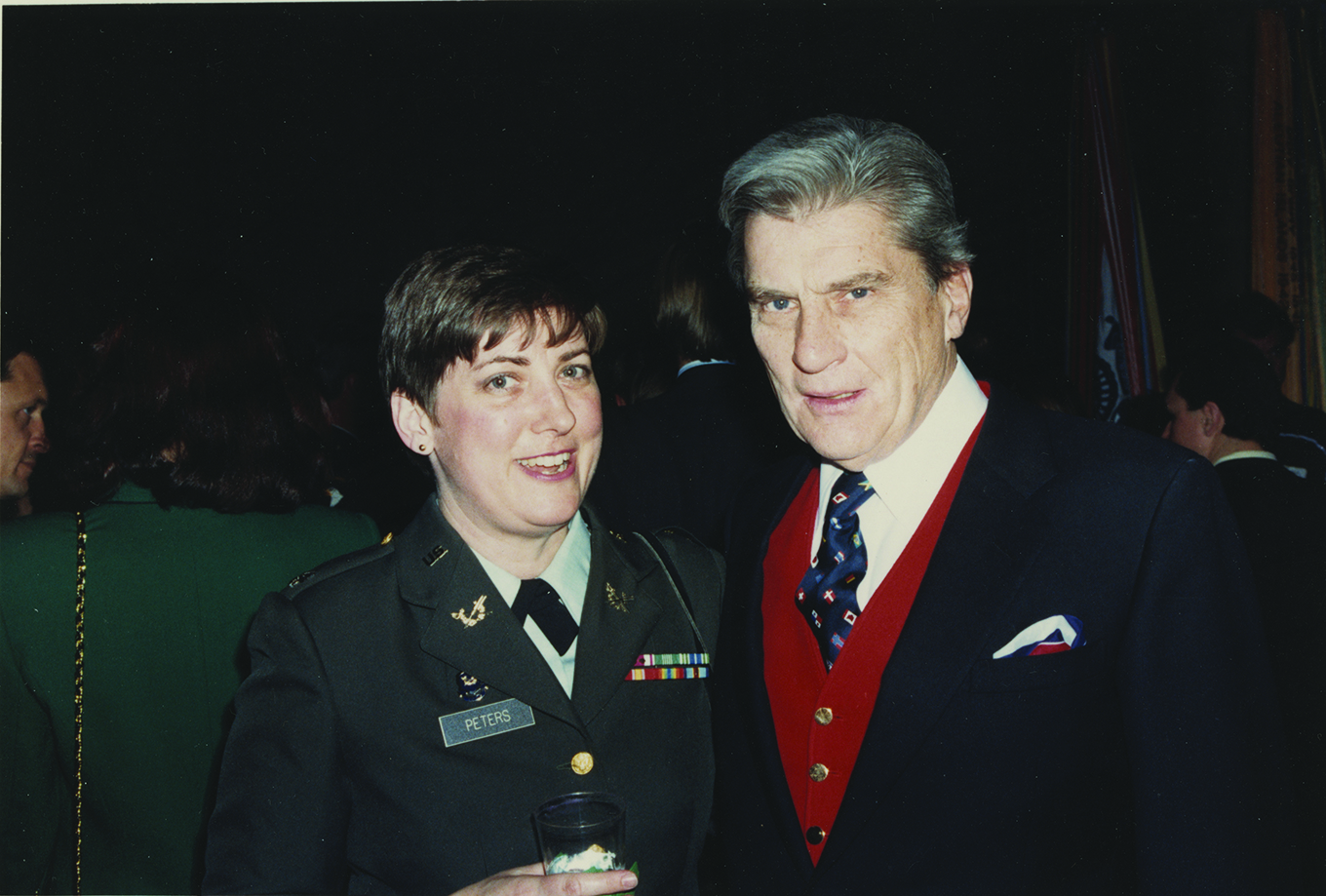
COL Joyce Peters (left) was the first female SJA at I Corps, Fort Lewis (now-Joint Base Lewis-McChord) and then the first female officer to serve as the Senior Military Assistant to the Secretary of the Army.
Joyce E. Peters
Joyce Peters had a remarkable career in our Corps. She was the first female JA to serve as the SJA for a general court-martial convening authority and the first female JA to be an Army Corps SJA. She also was the first JA in history to serve as the Senior Military Assistant to the Secretary of the Army, the first female JA to attend a Senior Service College, and the first female JA to be awarded the Distinguished Service Medal. Colonel Peters was the second female attorney to reach the rank of colonel—eighteen years after COL Liz Smith Jr. reached that rank.
Born in Ann Arbor, Michigan, in January 1947, Peters spent her childhood in Texas, Pennsylvania, Michigan, Kansas, and Ohio because her father’s job as a petroleum engineer meant frequent moves for the family. After graduating from Radcliffe College in 1968 and obtaining her law degree from the University of Michigan in 1971, Peters spent a year practicing law in Cleveland, Ohio, before joining the WAC in 1972.37
She was immediately—and permanently—detailed to the JAG Corps. After completing the 65th Judge Advocate Basic Course, then-CPT Peters served as a trial counsel and Chief, Administrative Law at V Corps, Frankfurt, Germany. She then returned to TJAGSA, where she was the only woman in her Graduate Course. She graduated first in the class in 1977 and then remained on the faculty, where she taught administrative and civil law.38
After leaving Charlottesville in 1980, Peters served in a variety of assignments, including DSJA, 2d Infantry Division, Korea, and Chief, Military Personnel Branch, Litigation Division, OTJAG. In 1986, she made history as the first female JA to be the SJA to the general court-martial convening authority at U.S. Army Logistics Center and Fort Lee. When she left that position in 1989, she went to the Pentagon, where she served three years in the Office of the Chief of Legislative Liaison. She also completed the National War College in 1992, she was the first female JA to attend an Army Senior Service College.
Promoted to colonel, Peters made military legal history once again as the first female SJA at I Corps and Fort Lewis, Fort Lewis, Washington. She served in this position until 1994, when she was selected by then-Secretary of the Army, Togo D. West Jr., to be his Senior Military Assistant—the first time in Corps history that a JA was chosen for this assignment. In fact, Peters was the first woman to serve in this position, and most likely the first non-combat arms officer chosen for the job. Colonel Peters retired in 1994.39
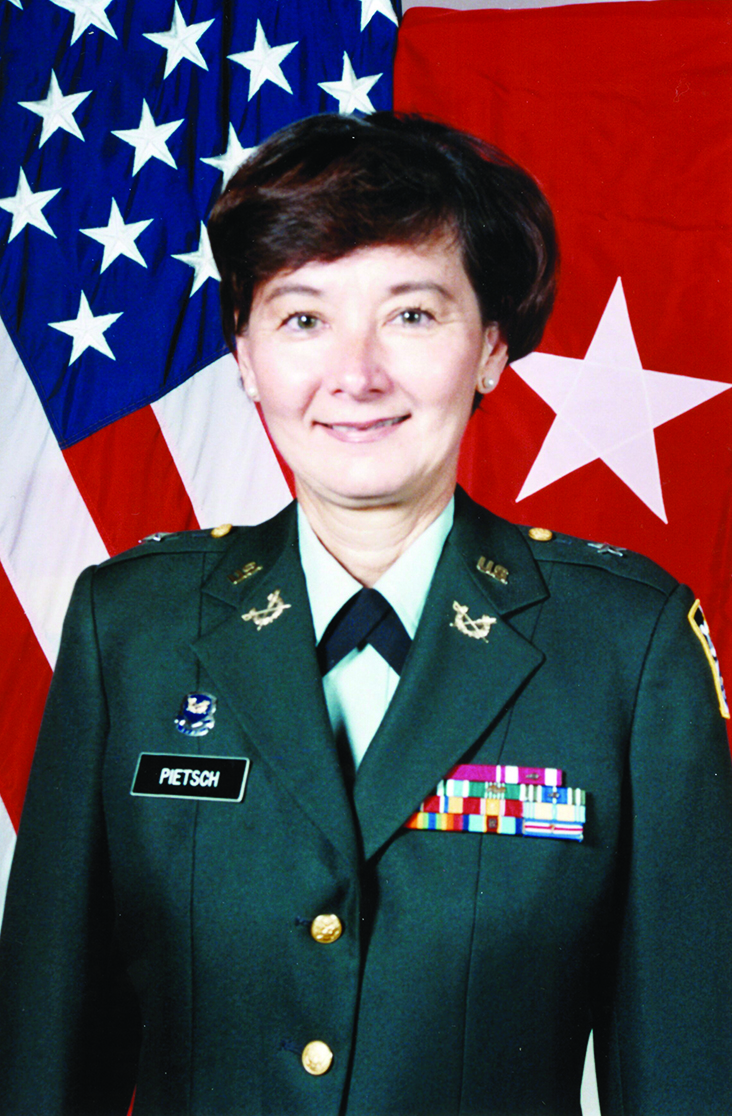
BG Coral W. Pietsch was the first female officer to be promoted to brigadier general in the Corps. Pietsch was an Army reservist.
Coral W. Pietsch
Coral Pietsch is the first female JA to reach flag rank in our Corps. She also is the first Asian-Pacific American female general officer in Army history. She was born in Waterloo, Iowa, to a Czech-American mother and a Chinese-immigrant father who had come to the United States to start a restaurant.40
Pietsch earned her undergraduate degree at the College of Saint Teresa and an M.A. in drama from Marquette University. She obtained her law degree from Catholic University, Washington, D.C. Commissioned into the JAG Corps in 1974, Pietsch served for four years on active duty in Korea and Hawaii before transferring to the Army Reserve.
After active duty, she served as a deputy attorney general for the State of Hawaii for six years. She then accepted a position as a Department of the Army (DA) civilian attorney at Headquarters, U.S. Army Pacific (USARPAC), Fort Shafter, Hawaii, rising to be the senior civilian attorney.
During her Army Reserve career, Pietsch held assignments as a contract law and claims officer at Headquarters, IX Corps (Augmentation), Fort DeRussy, Hawaii; contract law officer, chief of legal assistance, and chief of the administrative law division at Headquarters, IX Corps (Reinforcement), Fort DeRussy; and as the SJA, 9th U.S. Army Reserve Command, Fort DeRussy. As a reservist she deployed to Johnston Atoll, Japan, and the Philippines.41
Brigadier General (BG) Pietsch made history in July 2001, when she was promoted to general officer—the first female JA to achieve that rank. She then served as the Chief Judge (Individual Mobilization Augmentee) and Commander, Judicial/Defense Services Unit, until retiring in July 2006.42
But, even after leaving the Army Reserve, BG Pietsch continued to take on tough challenges. As part of the 2007 “surge” in Iraq, she volunteered as a Department of Defense civilian to deploy to Iraq for a year where she was seconded to the U.S. Department of State. Assigned to be the Deputy Rule of Law Coordinator for the Baghdad Provincial Reconstruction Team, Pietsch assisted numerous civil society projects involving a variety of rule of law partners, including the Iraqi Jurist Union, Iraqi Bar Association, law schools, and international rights, women’s rights, and human rights organizations. During her time in Iraq, she also established meaningful relationships with numerous Government of Iraq ministries, nongovernmental organizations, and Coalition partners to help reinvigorate the rule of law in Iraq.43
On 1 November 2011, President Obama nominated her to the United States Court of Appeals for Veterans Claims as his replacement for Judge William P. Greene (a retired JA colonel), who had reached the end of his fifteen-year term.44 The U.S. Senate confirmed BG Pietsch as the newest judge of the Court of Appeals on 24 May 2012.45 Her fifteen-year term will expire in 2027.46
Elyce K. D. Santerre
In 1988, CPT “Lisa” Santerre made history as the first recipient of the newly authorized LL.M. in military law. She achieved this distinction because she graduated first in the 36th Graduate Class in May 1988, which was the first class to receive the Masters of Law degree authorized by Congress just months earlier. Since the student graduating at the top of the class was the first to walk across the stage at TJAGSA, Santerre was the first to receive the new post-graduate law degree from Major General Hugh Overholt, who was presiding over the graduation ceremony.
Santerre was a 1975 graduate of the University of North Dakota. Commissioned as a lieutenant in the Transportation Corps, she served as a platoon leader and motor operations officer before entering law school as a FLEP student at the University of California-Berkeley. After graduating in 1981, and completing the Judge Advocate Officer Basic Course (JAOBC), she served at Fort Richardson, Alaska, and Fort Riley, Kansas, prior to attending the 36th Graduate Class.47
Then-CPT Santerre left active duty soon after receiving her LL.M. She continued her career as a DA civilian attorney in Alaska, where she specialized in labor law.48
Kathryn Stone
“Kat” Stone has a number of “firsts” in Corps history. She was the first female SJA at the 10th Mountain Division (Light Infantry) and Fort Drum, and the first female SJA in a combat zone (Afghanistan). Then-COL Stone also was the first female SJA at U.S. Southern Command and the first female JA to serve as the Executive Officer to TJAG.
A native of Florida, Stone completed her undergraduate degree at Stetson University in 1979. She was a Distinguished Military Graduate and consequently commissioned into the Army in MI. After taking an educational delay to complete law school at Stetson, then-CPT Stone elected to remain in MI in order to serve in Germany, before transferring to our Corps in 1987.49
In 2010, when she retired from active duty after twenty-seven years of active duty, COL Stone had served in a variety of assignments and locations, including: 8th Infantry Division (Mechanized), Germany; 6th Infantry Division (Light), Fort Richardson and Fort Greely; 2d Armored Division, Fort Hood; U.S. Special Operations Command South, Panama; and 10th Mountain Division (Light Infantry) and Fort Drum. While serving as the 10th Mountain Division SJA, then-LTC Stone deployed to Southwest Asia in late 2001 to serve as the SJA, Coalition Joint Task Force-Mountain during Operation Enduring Freedom. She arrived in Uzbekistan in early December 2001 and, while LTC Stone spent the early days of her deployment in Karshi Khanabad, she ultimately lived and worked in Bagram until re-deploying to Fort Drum. This deployment meant that Stone was the first female SJA to deploy to a combat zone.50
Colonel Stone also had previous service as the SJA, U.S. Special Operations Command South (SOCSOUTH). During this assignment in Panama, she deployed to Peru and Ecuador in late 1995 as part of Operation Safe Border. This SOCSOUTH mission deployed a small number of special forces personnel to prevent a limited border war between Peru and Ecuador from expanding into all-out war. Stone is now the top civilian attorney in OTJAG’s Professional Responsibility Office.51

COL Denise Vowell was the first female Chief Trial Judge.
Denise Vowell
Denise Vowell was the first female SJA at 1st Infantry Division and the first female Chief Trial Judge in Corps history. An honors graduate of Illinois State University, she earned her law degree through the FLEP at the University of Texas in 1981.52
Vowell enlisted in the Army in 1973 while an undergraduate and received a direct commission in the WAC in 1974. She served as a military police officer at Fort Knox and with the 1st Cavalry Division, where she was in command of a company at the time of her selection for the FLEP. As a JA, COL Vowell served in a variety of positions and locations, including: Government Appellate Division, Falls Church, Virginia; PP&TO, OTJAG; Tort Branch, Litigation Division, OJTAG, and Trial Judge and Chief Circuit Judge, 1st Judicial Circuit; and SJA, 1st Infantry Division. She made history when she was selected to serve as the first female Chief Trial Judge, U.S. Army Trial Judiciary. She retired from active duty in January 2006, and was then appointed by the Court of Federal Claims as a Special Master in the National Vaccine Injury Compensation Program by the judges. A year later, Vowell was assigned as one of three special masters in the Omnibus Autism Program, handling one-third of the court’s more than 5,000 cases alleging vaccine causation of autism spectrum disorders.53
2000s to Present
While hundreds and hundreds of women have served as JAs in the first two decades of the twenty-first century, and there are many who deserve mention, this short history can only identify a small number of them, and furnish limited details.
Rebecca E. Ausprung
Rebecca E. “Becky” Ausprung is one of four attorneys with Senior Executive Service (SES) status in the Corps. She is the Director, Civil Law and Litigation, USALSA. Ausprung began her career in the Corps as a uniformed attorney. From 1999 to 2001, she served at III Corps as a trial counsel and legal assistance officer before being reassigned to Germany, where she served first as a defense counsel in Kitzingen and the Senior Defense Counsel in Wuerzburg. Ausprung then served in the Litigation Division from 2004 to 2007 before leaving active duty and transitioning to the Army Reserve. She left the Reserve Component in 2012.54

BG LeAnne Burch was the first female commander of U.S. Army Reserve Legal Command.
LeAnne Burch
LeAnne Burch was the first female commander of U.S. Army Reserve Legal Command. She entered our Corps in 1986 and served on active duty until 1998, when she transitioned to the Army Reserve. Burch was a private practitioner in Arkansas for a few years before joining the Office of Chief Counsel, where she worked on cases involving child welfare and adult protective services.55
As she continued her JA career, then-COL Burch deployed to Afghanistan from September 2008 to August 2009. She was assigned to the Combined Security Transition Command-Afghanistan and served as the Chief, Afghan National Army/Ministry of Defense Legal Development.56
In 2012, Burch was selected for brigadier general, and she served first as the Reserve Chief Judge for USALSA before becoming the Commander, U.S. Army Reserve Legal Command in 2013. She retired from the Army Reserve in May 2016. Today, Burch serves in the House of Representatives in Arkansas, where she is the current Minority Whip.57
Kirsten Brunson
Kirsten Brunson was the first African-American female in our Corps to qualify and sit as a military trial judge. She graduated from the University of Maryland in 1987 and, having been cross-enrolled in Howard University’s Reserve Officers’ Training Corps program, commissioned into the Military Police Corps (MPC). But, Brunson received an educational delay and obtained her law degree from the University of California, Los Angeles in 1991.
Colonel Brunson joined the Corps and served in a variety of assignments, including: V Corps and XVIII Airborne Corps; Defense Appellate Division, USALSA; 101st Airborne Division; and U.S. Special Operations Command. After completing the Military Judges Course in 2008, she served as a trial judge at Fort Hood, Texas, before retiring from active duty.
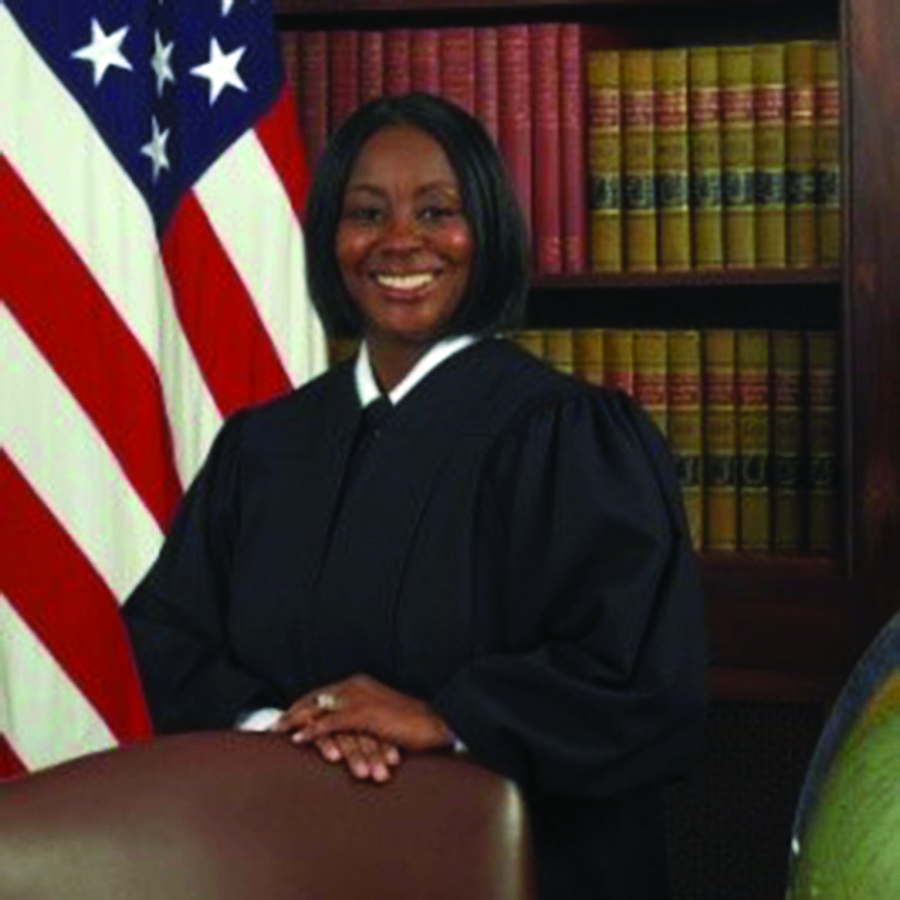
Judge Paulette Burton was the first African-American female to be a judge on the U.S. Court of Military Commissions Review.
Paulette V. Burton
Paulette Burton is the first African-American female JA to serve on the U.S. Court of Military Commissions Review (CMCR), a federal court created by Congress to hear appeals from military commissions. She was appointed by President Barack Obama to serve on the CMCR in May 2016. Lieutenant Colonel Burton became the Chief Judge of the CMCR in May 2017. Burton also is the first African-American female to serve as a judge on the Army Court of Criminal Appeals. She is now the Senior Judge on Panel 2.58
Karen H. Carlisle
Karen Carlisle is a member of the SES and is the Director, Soldier and Family Legal Service, OTJAG. She had a long career as a JA prior to joining the SES.59
Commissioned after graduating from college in 1990, Carlisle served first in the MPC before obtaining her law degree as a FLEP student at Florida State University in 1998. She then served in a variety of locations and assignments, including: DSJA, Fort Benning, Georgia; DSJA, U.S. Forces-Afghanistan; SJA, 1st Armored Division, Fort Bliss, Texas; Chief, Administrative Law, OTJAG; and SJA, U.S. Army Africa/Southern European Task Force, Vicenza, Italy. She retired from active duty in 2019.60
.jpg?ver=1tZxn69Mqjeq5iAC_QIPGg%3d%3d)
BG Marilyn Chiafullo is currently a brigadier general in the Army Reserve.
Marilyn S. Chiafullo
In May 2016, Marilyn S. Chiafullo was confirmed by the Senate to be a brigadier general in the Army Reserve. In her almost thirty years of active and Reserve service, BG Chiafullo has been the Chief of Staff, U.S. Army Reserve Legal Command, Chief of Reserve Component Management in OTJAG’s PP&TO, and SJA, Division West, First U.S. Army. She also has a combat tour in support of Operation Enduring Freedom while serving as the Theater Defense Counsel, U.S. Army Trial Defense Service, Afghanistan. In addition to her Army Reserve duties, BG Chiafullo serves as an attorney-advisor at PP&TO.
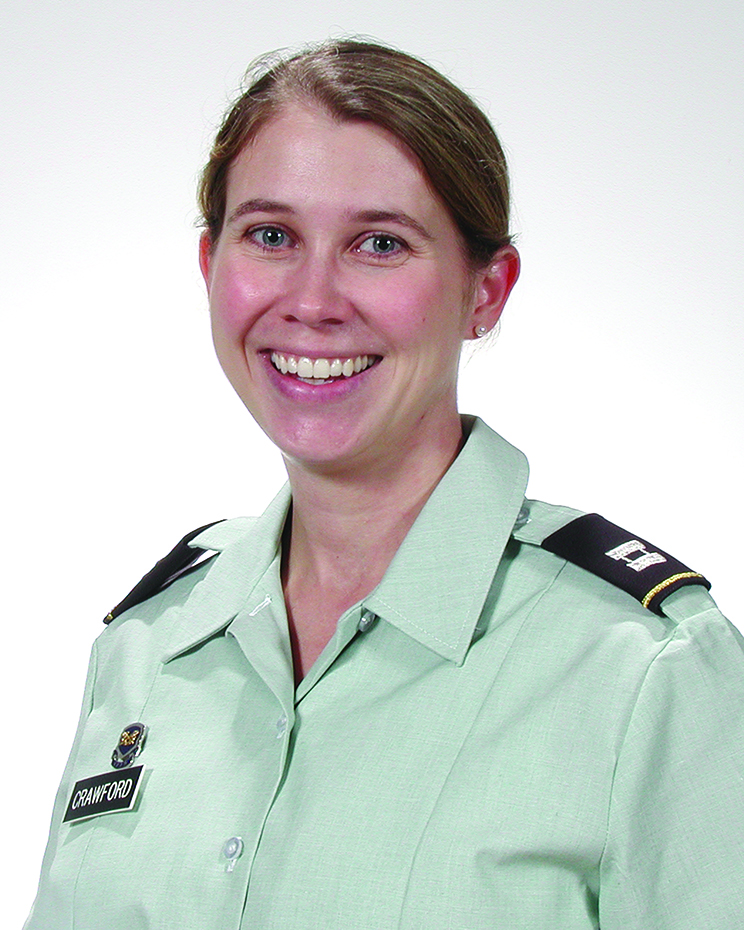
LTC Jennifer Crawford was Instructor of the Year at Command and General Staff College.
Jennifer L. Crawford
Jennifer “Jen” Crawford was the first JA named as the Military Instructor of the Year at Command and General Staff College. The award is presented yearly to be best military instructor and is based on “excellence in the four domains of teaching, service, scholarship and faculty development.”61
Lieutenant Colonel Crawford entered the Corps with a direct appointment in 1999 and served in a variety of locations and assignments, including Korea, Germany, and Iraq. Then-MAJ Crawford was an Assistant Professor at Command and General Staff College from 2006 to 2010, during which time she was named Military Instructor of the Year. She left active duty and transitioned to the Army Reserve. Lieutenant Colonel Crawford is currently serving as the Associate Dean for Adjunct Professors at TJAGLCS.62
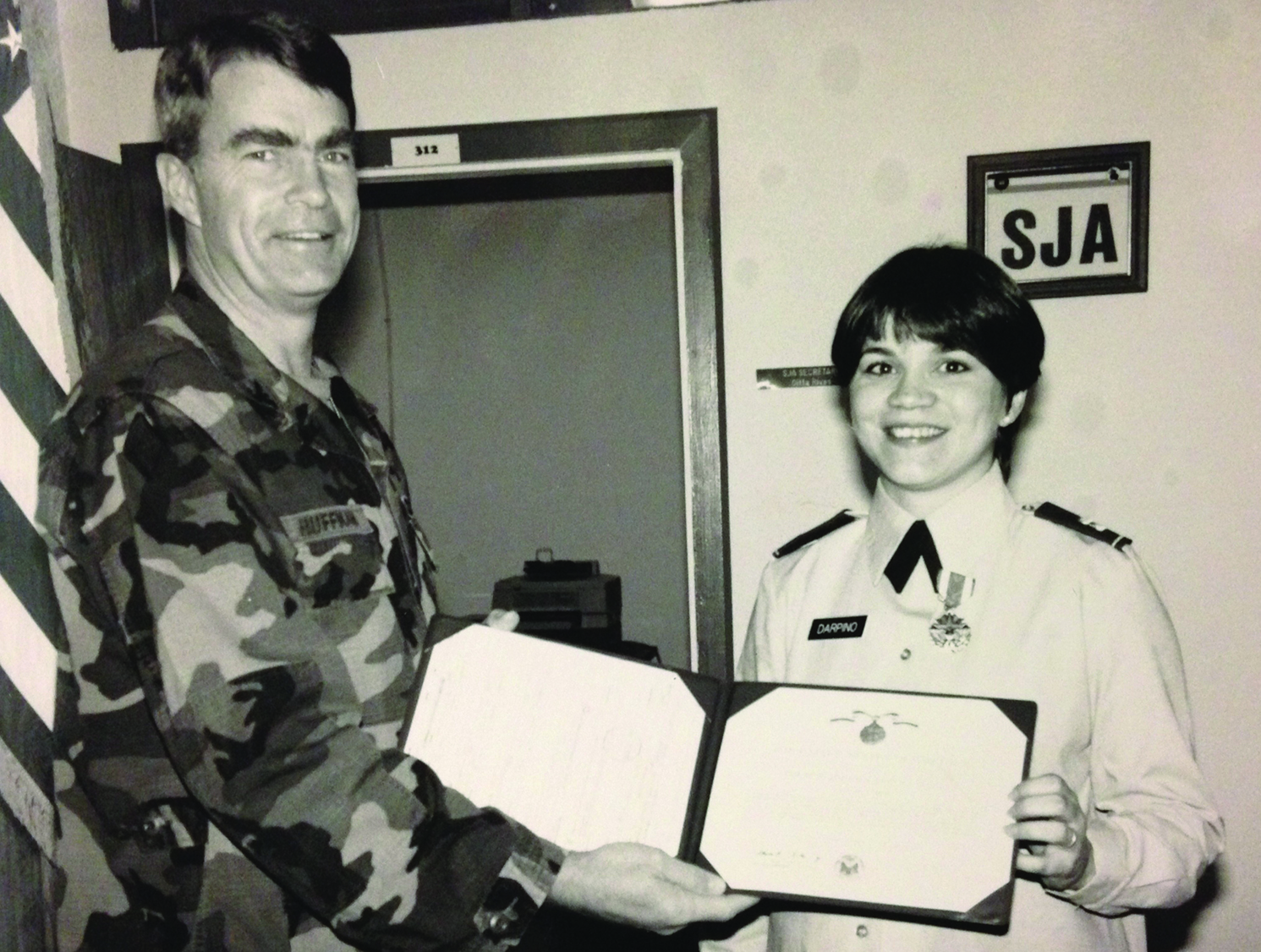
Then-CPT Flora Darpino receives an award from COL Walter B. Huffman. Huffman was TJAG from 1997 to 2001 and Darpino was TJAG from 2013 to 2017.
Flora D. Darpino
No JA—male or female—has been more successful in the twenty-first century than Lieutenant General (LTG) Flora D. Darpino. She was the first female TJAG, first directly commissioned officer to be the Army’s top lawyer in the modern era, and first half of a JAG Corps couple to achieve general officer rank. She also was the first female Commander at TJAGLCS. Finally, Darpino was an SJA at both a division and a corps in a combat zone.
Directly commissioned into our Corps in 1987 after receiving her law degree from Rutgers University, LTG Darpino served in a variety of assignments and locations, including Germany, Iraq, Texas, and the Washington, D.C. area. Then-LTC Darpino was the SJA, 4th Infantry Division (Mechanized), when that unit deployed from Fort Hood to Iraq in 2003. She subsequently served as the DSJA at III Corps at Fort Hood before working as the Chief, Criminal Law Division, OTJAG. Then-COL Darpino’s next assignment was as the SJA, V Corps, Heidelberg, Germany. She deployed to Iraq with that unit to serve as SJA, U.S. Forces-Iraq, where she was the senior military attorney in the country.
In 2009, Darpino was selected for brigadier general. She was the first female commander of TJAGLCS and later served as the Commander, USALSA, and Chief Judge, ACCA. Darpino was promoted to lieutenant general in September 2013 and served as the 39th Judge Advocate General of the Army until retiring in July 2017.
Susan Escallier
Susan K. Escallier was the second female SJA at the 101st Airborne Division (Air Assault). She also is the third female JA in the active component Army to reach general officer rank.63
After graduating from the University of California-Berkeley in 1988, Escallier was commissioned through ROTC in the Signal Corps. She subsequently served in the 25th Infantry Division until attending law school as a FLEP student at Ohio State University. After transferring to the Corps, she served in a variety of assignments and location, including Fort Bragg, North Carolina, and Fort Campbell, Kentucky, where then-COL Escallier was the SJA at the 101st Airborne Division (Air Assault). Her last assignment prior to being selected for brigadier general was at Fort Hood, Texas, where she was the SJA for III Corps. Brigadier General Escallier now serves as the Commander, USALSA and Chief Judge, U.S. Court of Criminal Appeals.64
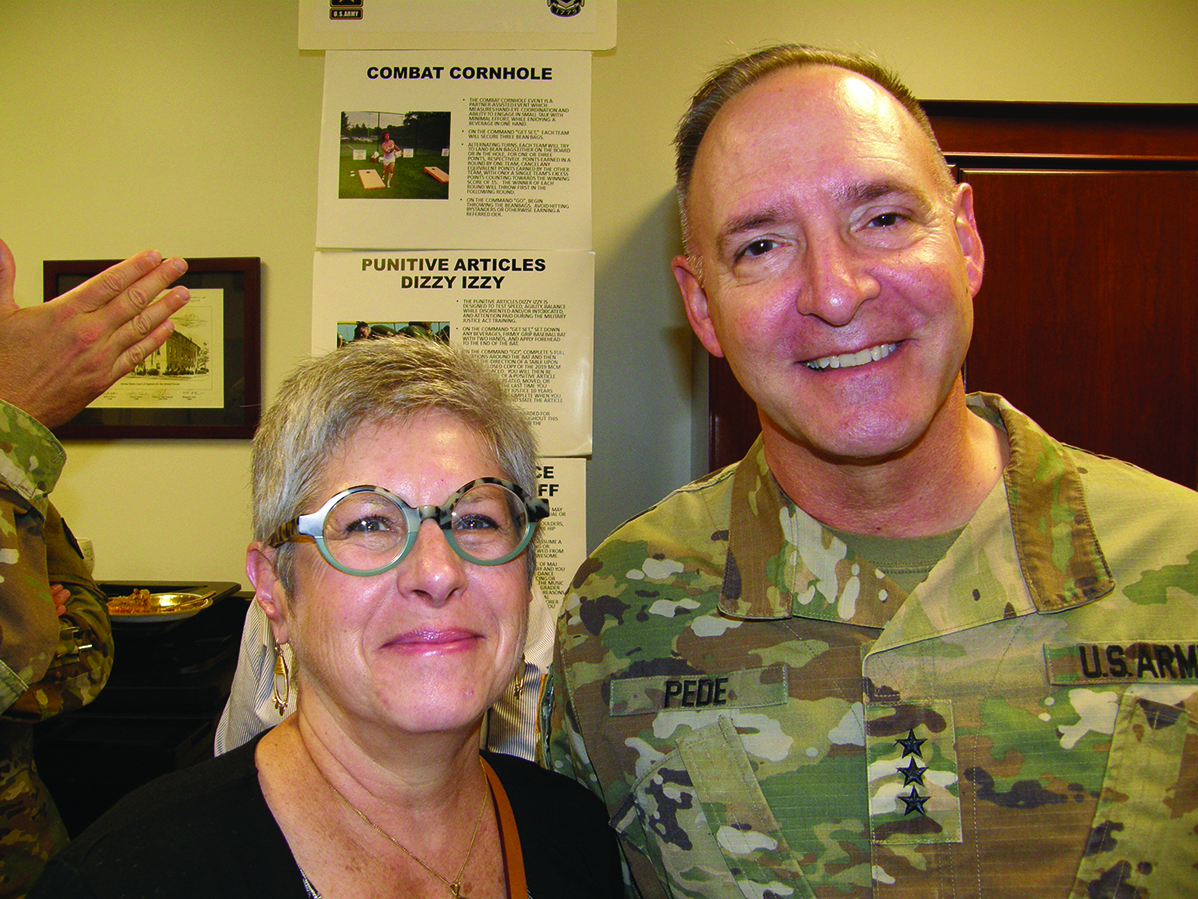
COL (Ret.) Patty Ham was the first female judge advocate to deploy in Desert Shield/Desert Storm. She was also the first female to head the Criminal Division at TJAGLCS. She is pictured here with LTG Charles Pede, The Judge Advocate General.
Patricia A. Ham (formerly Martindale)
In August 1990, then-CPT Patricia Martindale was the first female JA to deploy to Southwest Asia in Operation Desert Shield/Desert Storm in August 1990.65 Almost fifteen years later, from 2004 to 2006, then-LTC Ham was the first female chair of the Criminal Law Department at TJAGLCS. Her last active duty assignment was as the Chief of Staff, Response Systems to Adult Sexual Assault Crimes Panel. Colonel Ham retired in early 2015.66
Jeannine C. Hamby
The first and only female JA to be awarded the Soldier’s Medal—the Army’s highest decoration for non-combat valor. On 14 July 2002, Hamby “saved a second-year law student working in the Judge Advocate General’s Summer Intern Program from a violent rape attack.” As her citation explains:
When Major Hamby awoke to the screams of the intern being attacked by a male intruder in her house, she ran to find the naked male intruder attacking the terrified intern. Though Major Hamby was herself unarmed and in danger from the attacking intruder, she bravely confronted the attacker, interposed herself between the attacker and the terrified intern, and drove the attacker away from the intern and out of the house. Major Hamby then gave the police the information that led to the attacker’s arrest, line-up identification, and conviction.

COL Pam Harms (formerly Stahl), December, 2009 at Camp Higashi, Chitose, Hokkaido, Japan.
Pamela Harms (formerly Stahl)
Pamela “Pam” Harms was the first female SJA of the 101st Airborne Division (Air Assault). She also was the first female SJA at USARPAC.
Born in Aberdeen, South Dakota, COL Harms grew up on a farm. She earned a degree in English and Speech from Northern State University and completed her legal studies at the University of Denver. After directly commissioning into the Corps in late 1987, Harms served in a variety of assignments and locations, including: VII Corps, Stuttgart, Germany; 2d Corps Support Command, Nellingen, Germany, and Saudi Arabia (as part of Operations Desert Shield/Desert Storm); and DSJA, 1st Armored Division. Then-LTC Harms also served as the Chair, Administrative and Civil Law Department, TJAGLCS, and as the Director, Center for Military Law and Operations. While the SJA at the 101st Airborne Division, she deployed to Iraq to serve as the SJA, Multi-National Division-North and Task Force Band of Brothers. She completed her military career as the SJA, USARPAC.
Denise R. Lind
Denise Lind was the presiding judge in the high-profile general court-martial of Private First Class Bradley (now-Chelsea) Manning in 2012. After retiring from active duty in 2015, she took a position as an attorney advisor with the U.S. Military Commissions Trial Judiciary.67
Ellie Trefzger Morales
Army Reserve CPT Ellie Morales was the first female JA to be awarded the General Douglas MacArthur Leadership Award. This prestigious honor is presented to fewer than twenty Army junior officers each year.
After graduating from Davidson College, North Carolina, and obtaining her law degree from Wake Forest University, Morales joined the Corps in 2010. She served one tour in Afghanistan and transitioned to the Army Reserve in 2015. Today, she works as an Assistant U.S. Attorney for the Department of Justice.68
Tara A. Osborn
Tara Osborn served as the Chief Trial Judge of the U.S. Army until she retired as a colonel in 2017. In that position, she oversaw judicial operations at military installations worldwide, and led all active duty and Army Reserve judges of the U.S. Army Trial Judiciary. Osborn also presided over a number of felony criminal trials, to include the high-profile death penalty court-martial of MAJ Nidal Hasan at Fort Hood, Texas. Hasan was convicted of killing thirteen individuals and wounding another thirty men and women in a November 2009 mass shooting.69
In her JA career, COL Osborn served in a variety of assignments and locations, including Germany, Iraq, and Korea. Osborn had over twenty-nine years’ active duty in the Corps when she left active duty.70
Sharon E. Riley
Sharon Riley was the first female director of the Center for Law and Military Operations and the first female director of the Legal Center.
After receiving her law degree from Temple University, Riley directly commissioned into the Corps in January 1987. She subsequently served in a variety of increasingly important assignments, including: Officer in Charge, Schweinfurt Law Center, Germany, from 1996 to 1998 (which included being the DSJA (Forward), 1st Infantry Division, Tuzla, Bosnia from 1997 to 1998); SJA, 1st Armored Division, Baghdad, Iraq, and Wiesbaden, Germany; Director, Legal Center, TJAGLCS, from 2011 to 2014. She completed her career as the SJA, U.S. Army Training and Doctrine Command and retired in July 2015.71
Sarah J. Rykowski
Then-CPT Sarah Rykowski was the first female JA to be awarded the Purple Heart. On 17 May 2007, she was part of a convoy that was hit by an improvised explosive device. Rykowski was hit in the face with debris and a piece of shrapnel also pierced her bicep. She was the only survivor in her High Mobility Multipurpose Wheeled Vehicle; one of the Soldiers killed was Specialist Coty Phelps, an MOS 27D Paralegal Specialist.72
Conclusion
From only few female JAs in the 1940s and 1950s, the Corps today has more than 500 female lawyers in uniform. When one also considers that it was not until 1972 that a female wearing the crossed-pen-and-sword on her collar was promoted to colonel, and that another eighteen years would pass before a second female JA wore eagles on her shoulders, one can only conclude that gender equality was a long time coming. In retrospect, it is clear that it was not until the WAC was eliminated as a separate part of the Army in 1978 that progress was possible.
If anything, this short history of women in the Corps illustrates that once barriers to joining the Corps faded away, the chief problem for female JAs was upward mobility. Colonel Liz Smith, for example, knew that “promotion to colonel was a distant hope, at best.”73 Even in the early 1970s, senior JAs like Brigadier General Wilton Person, who would serve as TJAG from 1975 to 1979, was telling aspiring female lawyers like Joyce Peters that she would not be able to go beyond the rank of colonel.74 Certainly, Persons never anticipated that a woman would wear three stars and serve as TJAG while he was still living. In fact, female JAs now have served in every rank in our Corps except for major general, and one expects that this omission will disappear sooner rather than later. Moreover, there are few if any assignments that have not been filled by female Army lawyers, reflecting that gender is no longer a barrier to service. Certainly gender no longer is an obstacle to service in a combat zone, as more than a few female JAs have served as division- (e.g., then-LTC Flora Darpino at 4th Infantry Division) and corps-level SJAs (e.g. then COL Dunn at XVIII Airborne Corps).
While no one can be certain what the future will bring, if the past is prologue, then female JAs will continue to serve with honor and distinction. TAL
Mr. Borch is the Regimental Historian, Archivist, and Professor of Legal History and Leadership.
Notes
1. Bettie J. Morden, Women’s Army Corps, Historical Dictionary of the U.S. Army 519 (2001). For more on the WAC, see Bettie J. Morden, The Women’s Army Corps, 1945-1978 (1990), https://history.army.mil/html/books/030/30-14-1/cmhPub_30-14.pdf.
2. David Coleman, U.S. Military Personnel 1954-2014, History in Pieces, https://historyinpieces.com/research/us-military-personnel-1954-2014 (last visited Nov. 26, 2019).
3. Wolfgang Saxon, Phyllis Propp Fowle, 92, Officer in Army Judge Advocate Corps (sic), N.Y. Times B7 (June 26, 2000).
4. Id.
5. Id.
6. Id.
7. For a comprehensive look at Smith’s career, see Major George R. Smawley, The First Female Colonel of the U.S. Army Judge Advocate General’s Corps: A Summary and Analysis of the “Oral History of Colonel Elizabeth R. Smith, Jr. (USA Retired) (1951-1978),” 179 Mil. L. Rev. 171-209 (2004).
8. Id.
9. Id. at 183.
10. Id. at 184.
11. High Court Admits WAC to Practice, Sunday Star (Jan. 17, 1962).
12. Letter from Major General George Hickman to 1LT Elizabeth Smith (June 10, 1957) (unpublished) (on file with author).
13. Smawley, supra note 7, at 187.
14. Id.
15. Id.
16. Id. at 190.
17. U.S. Dep’t of Army, DA Form 67-5, Officer Efficiency Report—Elizabeth R. Smith Jr. (31 Mar. 1963).
18. Smawley, supra note 7, at 191.
19. Id.
20. Recruiters and personnel manning Armed Forces Examining and Entrance Stations (AFEES) faced demonstrators who threw real and artificial blood on them and their files, and one AFEES was bombed. Id. at 193.
21. Id.
22. Id.
23. The Judge Advocate General’s School, 22nd Advanced Class Directory 74 (1973).
24. Id.
25. The Judge Advocate General’s School, Commandant’s Annual Report (1970-71).
26. The Judge Advocate General’s School, Commandant’s Annual Report Fiscal Year 1974, at 11 (1974); Smawley, supra note 7, at 174.
27. Id.
28. About Us, American Inns of Court, http://home.innsofcourt.org/AIC/About_Us/AIC/AIC_About_Us/About_Us.aspx?hkey=72647b55-4a23-4263-8a3e-817098c808fa (last visited Nov. 26, 2019).
29. Id.
30. Id.
31. Executive Summary, An Oral History of Lieutenant Colonel (Ret.) Pamela Kirby (2017).
32. United States v. Treakle, 18 M.J. 646 (A.C.M.R. 1986); United States v. Thomas, 22 M.J. 388 (C.M.A. 1986). From 1984 to 1986, the Army Court of Military Review, reviewed—and reversed—a series of courts-martial tainted by unlawful command influence. United States v. Treakle, 18 M.J. 646 (A.C.M.R. 1986); United States v. Thomas, 22 M.J. 388 (C.M.A. 1986). See also S. Rep. No. 102-1 (1991).
33. U.S. Dep’t of Army, DA Form 4037, Officer Record Brief—Musetta Tia Johnson (27 June 2013).
34. M. Tia Johnson, U.S. Dep’t of Homeland Security, https://www.dhs.gov/archive/person/m-tia-johnson (last visited Dec. 15, 2019).
35. M. Tia Johnson, Georgetown Law, https://www.law.georgetown.edu/faculty/m-tia-johnson/ (last visited Dec. 15, 2019).
36. The Judge Advocate General’s School, 39th Judge Advocate Officer Graduate Class (1990).
37. Resume, Joyce E. Peters, Senior Military Assistant to the Secretary of the Army (1994) (on file with the author).
38. Id.
39. Id.
40. William Cole, Army Reserve Lawyer has Star Power: Island Resident First Female JAG General in Branch, Honolulu Advertiser A1 (July 24, 2001).
41. Id.
42. Judge Coral W. Pietsch, U.S. Court of Appeals for Veterans Claims, https://www.uscourts.cavc.gov/pietsch.php (last visited Dec. 5, 2019).
43. Id.
44. Id.
45. Id.
46. Id.
47. The Judge Advocate General’s School, 36th Graduate Class Directory (1987).
48. Id.
49. Email from Kathryn Stone to Fred Borch (Dec. 4, 2019) (on file with author).
50. Id.
51. Id.
52. Major Temi Anderson, Major Aaron Lykling & Major David O’Dea, The Judge Advocate General’s Legal Center and School, Charlottesville, Virginia, An Oral History of Denise K. Vowell, Colonel (Retired), U.S. Army 1973-2006, (Nov. 2012).
53. Id.
54. Email Rebecca E. Ausprung to Fred Borch (Dec. 9, 2019) (on file with author); Rebecca E. Ausprung Biography, JAGCNet, https://www.jagcnet2.army.mil/Sites/JAGC.nsf/E32E9DDF577B16338525827900671644/$File/Asprung%20Ms%20Bio%20and%20Photo%2020180424.pdf (last visited Dec. 9, 2019).
55. LeAnne Burch, State of Arkansas: House of Representatives, https://www.arkansashouse.org/district/9 (last visited Dec. 9, 2019).
56. Id.
57. Id.
58. Email from LTC Paulette Burton to Fred Borch (Dec. 9, 2019) (on file with author).
59. Karen H. Carlisle Biography, JAGCNet, https://www.jagcnet2.army.mil/Sites/jagc.nsf/0/EDBFA72D26A9752A85257D7300467912/$File/Carlisle%20SES%20Bio%20-%2020191101.pdf (last visited Dec. 9, 2019).
60. Id.
61. CGSC Graduation Awards, Command and General Staff College Foundation Inc., http://www.cgscfoundation.org/newsroom/cgsc-graduation-awards/ (last visited Dec. 9, 2019).
62. Reserve Command Military Service Automated Brief Record—Jennifer L. Crawford (Sept. 4, 2019) (on file with author).
63. The first two were Brigadier General Malinda Dunn and Lieutenant General Flora Darpino.
64. Brigadier General Susan K. Escallier Biography, JAGCNet, https://www.jagcnet.army.mil/Sites/JAGC.nsf//2EFE4CCC57EE647F8525817D0065477D/$File/Escallier%20BG%20Bio%20and%20Photo%20CDR%20USALSA.pdf (last visited Dec. 9, 2019).
65. Fred L. Borch, Judge Advocates in Combat 148 (2001).
66. Email from Patricia Ham to Fred Borch (Dec. 9, 2019) (on file with author).
67. Carol Rosenburg, Army Judge in Chelsea Manning Case Now Working at Guantanamo, Miami Herald (Oct. 22, 2015).
68. Woody Marshall, Road Not Taken, Davidson J., Spring-Summer 2019, at 15.
69. For a recitation of the facts, see Nidal Hasan v. United States, Army Court of Criminal Appeals (en banc), Memorandum Opinion and Action on Petitions for Extraordinary Relief in the Nature of a Writ of Prohibition and a Writ of Mandamus, Misc. 20120876, 20120877 (Oct. 18, 2012), https://www.jagcnet.army.mil/sites/acca.nsf/0/5D43DA05091A516B85257B43005496C2/$FILE/Memorandum_Opinion_18_Oct_12.pdf.
70. Biography—Colonel (Ret.) Tara A. Osborn (2017) (on file with author).
71. Id.
72. Kirsten Holmstedt, The Girls Come Marching Home 245 (2009).
73. Smawley, supra note 7, at 206.
74. Id.